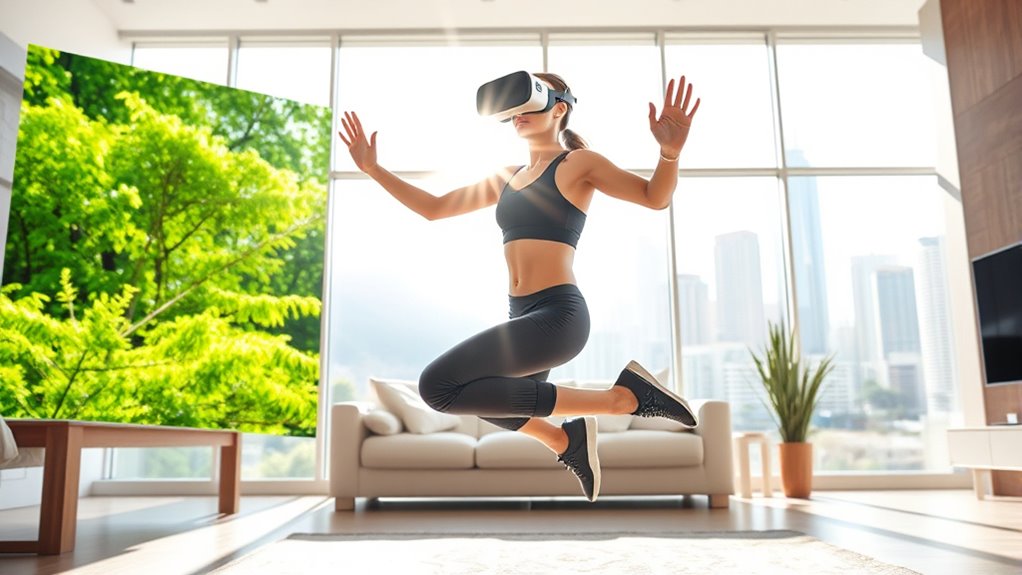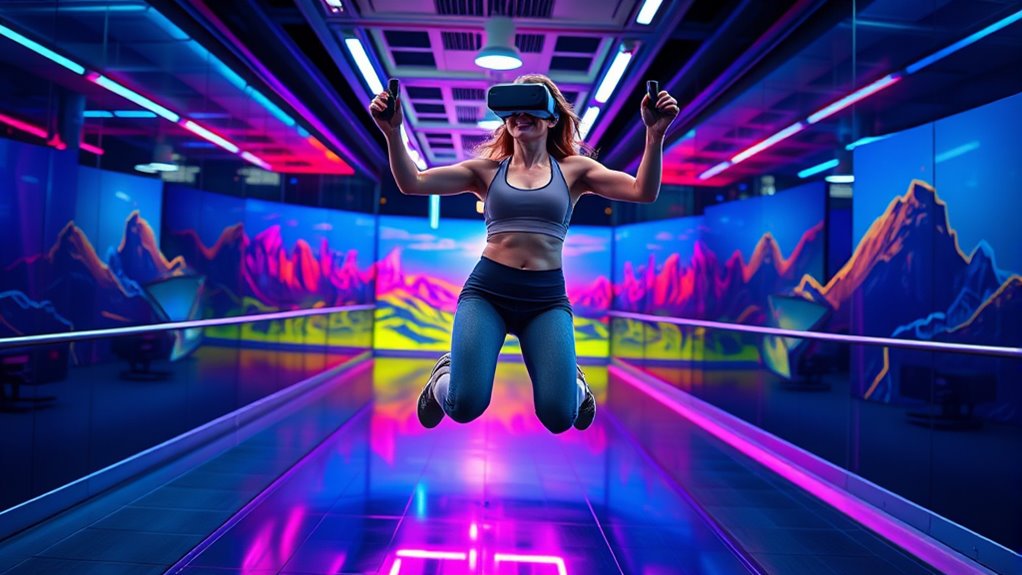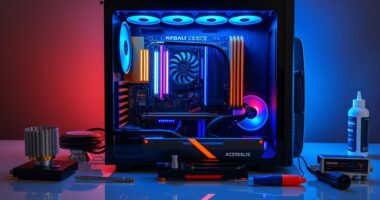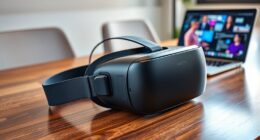VR fitness transforms workouts into immersive, exciting adventures that keep you motivated. You can climb mountains, box in stadiums, or dance on futuristic stages, all while customizing your experience to match your fitness goals. With accessories like VR headsets and haptic gloves, your movements feel real, making exercise feel more like play. Social features let you work out with friends or join virtual classes, and ongoing innovations mean your options will continue to grow—explore how it all works below.
Key Takeaways
- Virtual reality fitness transforms workouts into immersive experiences, increasing motivation and making exercise more engaging.
- VR accessories like headsets, controllers, and haptic gloves enhance realism and interaction during workouts.
- Customizable virtual environments and routines adapt to individual fitness levels and goals, promoting consistent progress.
- Multi-user platforms and social features boost accountability, motivation, and enjoyment through virtual group activities.
- Ongoing technological advancements integrate VR with hardware optimization, making virtual workouts more seamless and personalized.

Virtual reality fitness is transforming the way you work out by making exercise more engaging and immersive. Instead of slogging through traditional routines, you can now step into virtual worlds that turn fitness into an adventure. With the right virtual reality accessories, you’re fully immersed in these experiences, feeling like you’re actually climbing mountains, boxing in a stadium, or dancing on a futuristic stage. These accessories—such as VR headsets, motion controllers, and haptic gloves—are designed to enhance your connection to the virtual environment, making every movement feel real and purposeful.
Virtual reality fitness immerses you in exciting virtual worlds, making workouts engaging, fun, and highly personalized.
When you put on a VR headset, you instantly enter a different domain where your surroundings are dictated by the game or app you’re using. This immersion keeps you motivated, as you’re no longer just exercising; you’re participating in a story or challenge that captures your attention. The best part is that these immersive workout experiences are highly customizable—whether you prefer high-intensity cardio, strength training, or flexibility routines, there’s a virtual environment tailored to your goals. The immersive aspect also helps distract you from fatigue or boredom, which are common hurdles in traditional workouts.
Using virtual reality accessories, you can perform a variety of exercises that might feel more like play than work. For instance, you might dodge virtual objects in a boxing game, leap over obstacles in a parkour simulation, or perform yoga on a serene beach at sunset. These experiences make your workout feel less like a chore and more like an exciting activity you look forward to. Plus, many VR fitness apps track your progress and provide real-time feedback, helping you stay motivated and consistent. The technology also adapts to your fitness level, gradually increasing intensity as you improve.
The social aspect of VR fitness is another advantage. With multi-user platforms, you can work out with friends or join virtual classes from the comfort of your home. This social engagement boosts accountability and adds a competitive edge that pushes you further. As VR technology advances, the line between gaming and fitness continues to blur, encouraging you to move more and stay active without feeling like you’re doing a traditional workout. With immersive workout experiences powered by high-quality virtual reality accessories, getting in shape becomes an exciting journey rather than a tedious task. You’ll find yourself enthusiastic to jump into your virtual gym and explore new ways to challenge your body—all while having fun in the process.
Additionally, integrating Tesla Tuning insights into VR fitness could help optimize the hardware performance, ensuring a smoother and more responsive experience during your workouts.
Frequently Asked Questions
What Safety Precautions Should I Take During VR Workouts?
When considering VR safety during workouts, you should always clear your space to avoid workout hazards like tripping or hitting objects. Make sure you’re wearing the headset properly and taking regular breaks to prevent eye strain and fatigue. Stay aware of your surroundings, especially if you’re new to VR. By following these safety precautions, you’ll enjoy your VR workouts without risking injury or discomfort.
Can VR Fitness Help With Specific Medical Conditions?
You might think VR fitness isn’t for medical conditions, but it actually offers notable medical benefits and rehabilitation potential. You can target specific needs like improving mobility, balance, or strength in a controlled, safe environment. VR workouts are adaptable for various conditions, making them a useful supplement to traditional therapy. Always consult your healthcare provider first, but VR fitness can support your recovery and enhance your overall well-being effectively.
What Equipment Is Necessary for a Complete VR Fitness Setup?
To set up a complete VR fitness system, you need a compatible VR headset that matches your device’s specs. Make sure your space requirements are met—usually a clear, open area for safe movement. You’ll also want motion controllers for interaction and possibly sensors or base stations for tracking. Check VR headset compatibility with your PC or console, and clear enough space to move freely without obstacles.
How Do I Prevent VR Motion Sickness During Workouts?
To prevent VR motion sickness during workouts, try motion sickness remedies like taking breaks and staying hydrated. Use visual adjustment techniques such as reducing the field of view or adjusting headset settings for clarity. Make sure your VR environment is well-lit and seated comfortably. Gradually increase your session time to build tolerance. These steps help your brain adapt, making virtual workouts more enjoyable and less nausea-inducing.
Are There Age Restrictions for Participating in VR Fitness Programs?
Age restrictions for VR fitness programs vary depending on the platform and activity. Typically, developers recommend a minimum age, often around 13 or 16, to ensure safety and suitable fitness levels. You should verify the specific program’s guidelines, as they consider physical maturity and fitness levels. Always consult with a healthcare professional if you’re unsure, especially for younger or older participants, to ensure a safe and enjoyable experience.
Conclusion
As you step into the world of VR fitness, you hold the key to opening your inner strength, much like a warrior gripping their sword. The headset becomes your portal to endless possibilities, transforming workouts into adventures. Embrace this new chapter, knowing each virtual victory is a step closer to your true self. Remember, your journey isn’t just about fitness—it’s about discovering the hero within, ready to conquer both digital worlds and real life.









